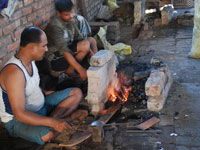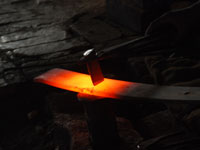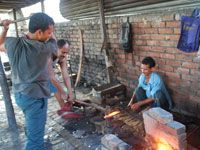The Making of a Khukuri: From Steel to Symbol
The Khukuri, Nepal’s iconic weapon and symbol of bravery, is much more than just a knife. It is a product of centuries of craftsmanship, a unique blend of artistry and utility, forged by the skilled hands of Nepal’s blacksmiths, known as Kamis. This age-old profession has been passed down through generations, with each blade representing not just a weapon, but a piece of cultural heritage.
In Nepal, there are two main groups responsible for crafting the Khukuri. The Kamis, also known as blacksmiths or ironsmiths, are the primary artisans responsible for forging the blade. The Saarkis, another tribe in Nepal, specialize in creating the sheath that protects and complements the blade. Together, these two groups combine their craftsmanship to produce the complete Khukuri. The Kamis are particularly skilled in shaping metal and using traditional techniques that have been refined over centuries. Meanwhile, the Saarkis add their expertise to fashion the intricate, durable sheaths that house the blades.
Each Khukuri is handmade with a high level of care, ensuring that only the finest materials are used. More than 10,000 blacksmiths in Nepal are involved in the production of Khukuris, with a select few known for their mastery in blade crafting.
Crafting a Khukuri starts with careful selection of the raw materials. The steel, often sourced from discarded vehicle springs like those from cars, buses, or trucks, is chosen for its durability and strength. This steel, along with brass, buffalo horn, wood, and leather, is gathered from local markets or directly from the villages by the artisans themselves. The process begins with sourcing materials such as rhododendron wood for the handle, buffalo horns for the fittings, and buffalo hide for the sheath. Every single item used is meticulously chosen, ensuring the best possible quality for the final product.
The Sheath: Protecting the Blade
Once the blade is finished, the sheath is crafted by the Saarkis, the other tribe responsible for the Khukuri’s creation. The sheath is typically made from buffalo hide, which is durable and flexible enough to hold the blade securely while allowing it to be drawn quickly when needed. The craftsmanship involved in making the sheath is just as important as the blade itself, as it not only serves as protection but also complements the overall design of the Khukuri. The sheath is often adorned with intricate designs, showcasing the artistry of the Saarki artisans.
Conclusion: The making of the Nepali Khukuri is a process that requires patience, skill, and passion. It represents the heart of Nepal’s blacksmithing tradition and stands as a symbol of the country’s resilience, craftsmanship, and rich history.
Final Touches: Inspection and Perfection
Once the Khukuri is fully assembled, it goes through a rigorous inspection process. Every detail is checked— from the sharpness of the blade to the sturdiness of the handle. These weapons are meant to be used in combat, and their effectiveness depends on the precision with which they are crafted. Only after passing a series of inspections will the Khukuri be ready for distribution.
The final product is a work of art. Not only is it an effective weapon, but it is also an exquisite piece of craftsmanship, reflecting the rich cultural heritage of Nepal. Whether it’s used by a soldier or displayed as a collector’s item, each Khukuri carries with it the skill and dedication of the craftsmen who created it.
the Nepali Khukuri continues to be a symbol of strength, resilience, and tradition, admired and respected across the globe.



